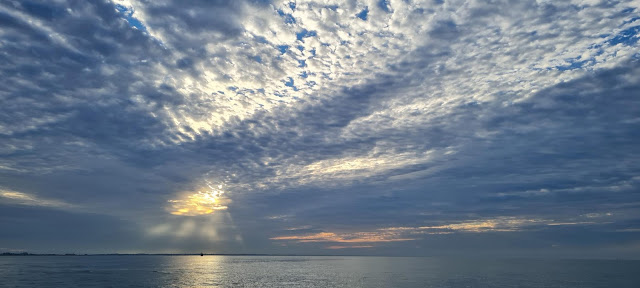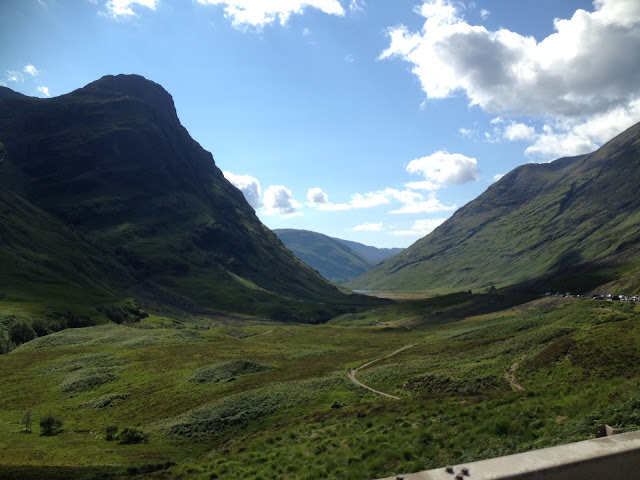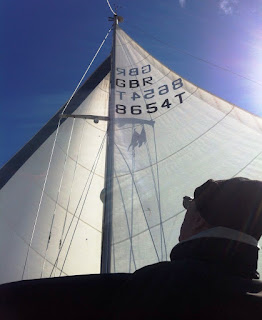Glencoe - a special place
I thought I must do Glencoe justice so I am picking up some bits and pieces about Glencoe for you to read at your leisure, if you are interested.
 Queen Victoria wrote in her diary of Glencoe; "Emerging from the village we entered the Pass of Glencoe, which at the opening is beautifully green, with trees and cottages dotted about along the verdant valley. A sharp turn in the rough, very winding and in some parts precipitous road, brings you to the finest, wildest and grandest part of the pass. Stern, rugged, precipitous mountains with the beautiful peaks and rocks piled high one above the other, two and three thousand feet high, tower and rise up to the heavens on either side, without any signs of habitation."
Queen Victoria wrote in her diary of Glencoe; "Emerging from the village we entered the Pass of Glencoe, which at the opening is beautifully green, with trees and cottages dotted about along the verdant valley. A sharp turn in the rough, very winding and in some parts precipitous road, brings you to the finest, wildest and grandest part of the pass. Stern, rugged, precipitous mountains with the beautiful peaks and rocks piled high one above the other, two and three thousand feet high, tower and rise up to the heavens on either side, without any signs of habitation."
It has also been described as the most romantic place in Scotland.
It is also filled with myths and legends and of course the terrible Glencoe Massacre of 13 February 1692. You can read about that at your leisure as there is plenty of information about it on line.
 However I came across this interesting article and I think it is worth repeating it here. The sword in the water was written by local amateur historian Arthur Smith who was bought up in the 1930s by his Gaelic speaking granny who told him this story of Corrag the Witch. (Thanks to the book National Trust for Scotland Glencoe www.nts.org.uk/glencoe.)
However I came across this interesting article and I think it is worth repeating it here. The sword in the water was written by local amateur historian Arthur Smith who was bought up in the 1930s by his Gaelic speaking granny who told him this story of Corrag the Witch. (Thanks to the book National Trust for Scotland Glencoe www.nts.org.uk/glencoe.)
"At the time of the massacre the witch Corrag warned the clan that the Redcoats were up to no good, but no one listened to her. The evening before the massacre Corrag fled to the hills, wrapped herself in a plaid and stayed out all night. She came back the next day and of course the village was empty, the houses burnt and cattle driven off and there was just the haze of smoke lying over the glen. The myth is that she went to where Maclain (the chief) had been shot and took his sword and threw it into the water, prophesising that the men of the glen had suffered enough. As long as that sword lay undisturbed by the hand of man, no man from this glen would ever die by the sword again.
Arthur checked and found out that nobody from Glencoe was killed at Culloden, Waterloo, or the thin red line Balaclava, the Boer Wars or was killed in any of the Victorian wars of 914-16. But then in June 1916 the captain of a dredger went into the Glencoe Hotel with the handle of an old sword, the local men were horrified and rowed out into the loch and threw it back. The fact is that the next morning 7 men from the village were killed at the Western Front. "
 Queen Victoria wrote in her diary of Glencoe; "Emerging from the village we entered the Pass of Glencoe, which at the opening is beautifully green, with trees and cottages dotted about along the verdant valley. A sharp turn in the rough, very winding and in some parts precipitous road, brings you to the finest, wildest and grandest part of the pass. Stern, rugged, precipitous mountains with the beautiful peaks and rocks piled high one above the other, two and three thousand feet high, tower and rise up to the heavens on either side, without any signs of habitation."
Queen Victoria wrote in her diary of Glencoe; "Emerging from the village we entered the Pass of Glencoe, which at the opening is beautifully green, with trees and cottages dotted about along the verdant valley. A sharp turn in the rough, very winding and in some parts precipitous road, brings you to the finest, wildest and grandest part of the pass. Stern, rugged, precipitous mountains with the beautiful peaks and rocks piled high one above the other, two and three thousand feet high, tower and rise up to the heavens on either side, without any signs of habitation."It has also been described as the most romantic place in Scotland.
It is also filled with myths and legends and of course the terrible Glencoe Massacre of 13 February 1692. You can read about that at your leisure as there is plenty of information about it on line.
 However I came across this interesting article and I think it is worth repeating it here. The sword in the water was written by local amateur historian Arthur Smith who was bought up in the 1930s by his Gaelic speaking granny who told him this story of Corrag the Witch. (Thanks to the book National Trust for Scotland Glencoe www.nts.org.uk/glencoe.)
However I came across this interesting article and I think it is worth repeating it here. The sword in the water was written by local amateur historian Arthur Smith who was bought up in the 1930s by his Gaelic speaking granny who told him this story of Corrag the Witch. (Thanks to the book National Trust for Scotland Glencoe www.nts.org.uk/glencoe.)"At the time of the massacre the witch Corrag warned the clan that the Redcoats were up to no good, but no one listened to her. The evening before the massacre Corrag fled to the hills, wrapped herself in a plaid and stayed out all night. She came back the next day and of course the village was empty, the houses burnt and cattle driven off and there was just the haze of smoke lying over the glen. The myth is that she went to where Maclain (the chief) had been shot and took his sword and threw it into the water, prophesising that the men of the glen had suffered enough. As long as that sword lay undisturbed by the hand of man, no man from this glen would ever die by the sword again.
Arthur checked and found out that nobody from Glencoe was killed at Culloden, Waterloo, or the thin red line Balaclava, the Boer Wars or was killed in any of the Victorian wars of 914-16. But then in June 1916 the captain of a dredger went into the Glencoe Hotel with the handle of an old sword, the local men were horrified and rowed out into the loch and threw it back. The fact is that the next morning 7 men from the village were killed at the Western Front. "




Comments
Post a Comment